 |
US Military Aviation
Flight Helmets
US NAVY late 40s-50s |
 |
The development of Jet aircrafts during the late 40s led the understanding that the flight headgear used so far on propeller aircraft was not any more suitable to adequatly protect the pilots during the new typic flight and combact performances of the jet aircrafts.
In particular the increasing noise of the aircraft engine and the utilization of the ejection seat system at higher speeds and altitudes led to the development of rigid shell helmets which provided much more noise attenuation as well as head protection in case of high speed bail-out or an emergency crash.
After the early non standardized "transitional" helmet the first hard standard US NAVY helmets were of the H series in several versions from H-1 to H-5. Nevertheless during the 50s the utilization of the USAF P series flight helmets by US NAVY pilots is also documented. At the end of the 50's a completely newly designed flight helmet was introduced: the APH-5 with its innovative visor mechanism and relevant protective housing.
Early "transitional" rigid flight helmets
During the late 40's the early rigid flight helmets were still not standardized, some of those were customized by the pilots themself or constructed by private aircraft company personnel for their own use. These "transitional" helmet were manufactured using elements coming from WW II softs flight headgear modified with rigid parts coming from helmets used on army tankers, race-cars, or football game.
Even as this "transitional" helmet was finding application in the first US jet, research on hard protective helmets incorporating communications and oxygen mask attaching system, was being conducted by the Air Force's Wright Patterson Aero Lab and Northrop Aviation's Dr. Charles Lombard. these research lead to development of the ancestors of the early standard flight helmets. Some of these helmets were manufactured by Protection Incorporated owned by Dr. Lombard, Herman and Roth. |
| Early not standardized US Navy flight helmet worn by USN test pilot in 1946. (US NAVY) |

|

|
Another similar not standardized flight helmet worn by US Navy pilot during the late 40s/early50s. (US NAVY) |
| Customized flight headgear worn by Naval aviator CDR Turner Caldwell during his flights on US Navy experimental jet aircraft D-558-1 Skystreak in 1947 (Douglas) |

|

|
US Navy test pilot on jet fighter FJ-1 Fury with customized flight headgear in 1948 (US NAVY) |
| Douglas production test pilot Bill Bridgeman wearing a probable "custom-built" Protecton Incorporated type flight helmet. Bridgeman was involved in the flights on US NAVY experimental jet/rocket aircraft D-558-2 Skyrocket in 1949-50. (Douglas) |

|

|

|
Rear Admirals Edgar A. Cruise, Daniel V. Gallery and Apollo Soucek, wearing "custom-built" Protecton Incorporated style prototype of rigid flight helmets, posed beside an US NAVY first jet fighter FH-1 Phantom I on 1948. (US NAVY) |
| Early not standardized US Navy flight helmet incorporating communication system and external boom mounted microphone. |

|

|
US Navy pilot during the half of 50s wearing what seems to be an early not standardized flight helmet retrofitted with "Christmas tree" bayonet receivers and P serie helmet's visor. (US NAVY) |
| Well preserved example of a probable US Navy "custom-built" Dr. Lombard type flight helmet. This specimen is painted in dark gold paint. Note the curved shape at the rear which remainds the design later used on the H-1 helmet. These type of not standardized helmets predates the 3BM TOPTEX helmet. (tbirdpk) |

|

|

|
Another very interesting early not standardized US Navy flight helmet "custom-built" Protecton Incorporated type painted with the Squadron color marking. |
US NAVY pilot from VF-5A (VF-51) with a "custom-built" flight helmet during the 1948.
(US NAVY) |

|

|
US Navy pilot Lt. Jg Hugh J. Tate on F2H Banshee wearing a probable "custom-built" Protecton Incorporated type flight helmet.
(US Navy) |
| US Navy pilot during the late 40s in what must be tests of the USAF Style B-1 " transitional" helmets . (US NAVY and Best of Flightgear) |

|

|

|
LCDR Robert M. Elder from VF-5A (VF-51) during the 1948 with what could be an USAF Style B-1 " transitional" helmets. (US Navy) |
Douglass test pilot Jhonny F. Martin with a possible early "custom-built" Protecton Incorporated type flight helmet in the 1948 during the test flight on D-558-2.
(US Navy) |

|

|

|
Early US Navy rigid helmet from NATC customized with modified football leather helmet and AN6542-2 Avionics. |
 |
H-1
The H-1, introduced in 1948 and made by General Textile Corporation (Now GENTEX) was the first US NAVY standard hard flight helmet for fighter aircraft.
The H-1 incorporates the earphone and a boom mounted microphone M-6A/UR to be used below 10.000 feet. Above this altitude an A-13A or A-14 oxygen mask were used Those were secured to fast snap bottoms placed on lateral sides of helmet's fiberglass cloth reinforced with epoxy resin shell or in the later version on external leather tabs. The early variant of H-1 do not possess the chin strap which was retrofitted in the later version. The internal pads were made of sponge rubber covered with chamois lining.
Black rubber goggles B-8 (or only the relevant lens) were normally worn but in some case a USAF P series external visor was also installed.
The H-1 has a characteristic and unique curved shape at the rear. |
|
| H-1 flight helmet belong to Lt. Everett Logue Wheeler from VC-3 Blue Nemesis. This later model has the oxygen mask attaching snaps on external leather tabs. This specimen has been retrofitted with snaps on upper frontal edge to be used to fix some kind of protective goggles or visor. |

|

|
US MARINES pilot 1st Lt "Dick" Smith beside an FH-1 Phantom I on 1949 wearing H-1 flight helmet. The visor taken from B-8 goggles was attached on the frontal helmet's edge by a pivot bracket. (USMC) |
| US MARINES pilot 1st Lt "Mac" McManus wearing a H-1 flight helmet with B-8 goggles. (USMC) |

|

|
US Navy pilot LTJG Leonard Plog on F9F-3 Panther wearing an H-1 flight helmet and A-13A oxygen mask on 1950. also In this case the visor and the relevant secured strap came from a B-8 goggles. (US Navy) |
| H-1 later version flight helmet. Note the characteristic and unique curved shape at the rear and the plug on the side of the shell for the oxygen mask communication cable. (Milehigh) |

|

|

|
US Navy pilot wearing an H-1 flight helmet. Note the boom microphone position and the five (for each side) oxygen mask attaching snaps. (US Navy) |
H-1 flight helmet. displayed at Naval Aviation Museum of Pensacola. Note the internal pads and the external leather tabs used in the later version of H-1.
(Maurizio Bressan) |

|

|
US NAVY early version of H-1 with studs placed directly on the helmet shell and oxygen mask A-13A (DocBoink) |
| Another well preserved specimen of early H-1 flight helmet. |

|

|

|
later version of H-1 flight helmet with oxygen mask studs on external leather tabs. Note the simple dark visor which some pilots customized from the B-8 goggles. |
| Early version of H-1 flight helmet with oxygen mask studs on external helmet shell. Note the characteristic and unique curved shape at the rear. (Bellsaviation.com) |

|

|

|
VF-11 pilots in 1950 with early version of H-1 flight helmet. (US Navy) |
| Early version of H-1 flight helmet with only three oxygen mask studs on each side of the external helmet shell instead of the five normally installed. |

|

|

|

|
Other awesome later version of H-1 flight helmet. (Bellsaviation.com) |
| US Navy pilots on board of USS Coral Sea in 1950 with H-1 later variant flight helmets (US Navy) |

|

|

|
Interesting US Navy H-1 late variant of the early 50s retrofitted with P-3 external visor. |
| US Navy H-1 early variant in the color of Blue Angels Flight Exibition Team. This helmet was used by Capt. Chuck Hiett who was the first US Marines pilot to joint the team in 1954. |

|

|

|
XB-51 test pilots during the 1949 wearing H-1 helmet modified with unusual full face visor. |
| Interesting US Navy H-1 early variant modified with lateral starps for a better goggle fixation. |

|

|

|
US Navy H-1 helmet early variant with external tabs and still without plug for Oxygen mask com cord and switche for boom vs oxygen mask microphone utilization. |
| Another US Navy H-1 helmet early variant with external tabs and chin strap. |

|

|

|
US Navy H-1 helmet early variant with MS22001 Oxygen mask. (Smithsonian Museum) |
| US Navy H-1 helmet early variant used by NATC test pilot with pivot visor customized from B-8 Goggle |
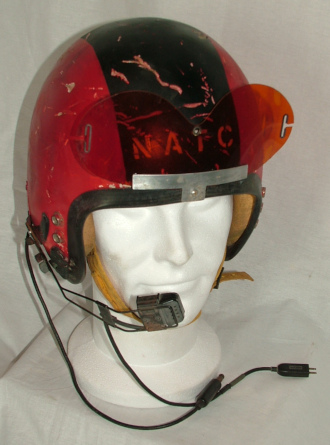
|
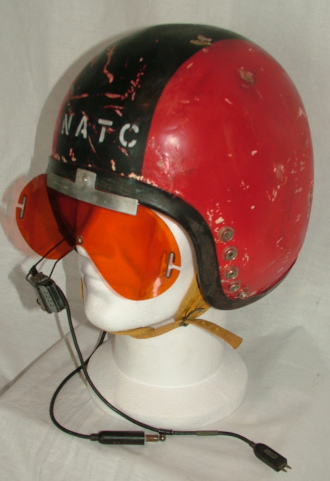
|
 |
H-2
This rare helmet was an advanced version of H-1 and was used for a short period during the early 50s. The fiberglass cloth reinforced with epoxy resin shell has the characteristic reinforcing ridges which in different shape were maintained in the subsequent H-3 and H-4 helmets.
The H-2 incorporates the earphone and a boom mounted microphone M-6A/UR to be used below 10.000 feet. Above this altitude an A-13A or A-14 oxygen mask were used These were secured to fast snap bottoms on external leather tabs. Black rubber goggles B-8 were normally worn but in some case a USAF P series external visor could may have been also installed.
In the rear right side of the helm a switch to fast switch the communication from the external boom microphone to the oxygen mask one was located. |
|
This yellow painted H-2 was damaged by automatic weapon fire during Korea war on 1952.
This helmet, now displayed at Naval Aviation Museum of Pensacola, belonged to Lt.Jg. Paul Cooper flying on Skyraider of VF-194. |

|

|
H-2 lateral view, note the back switch for a rapid communication switch from boom mounted microphone to the oxygen mask one. (DocBoink) |

|

|
The H-2 like the previous H-1 incorporates the earphones in the inernal liner thus no inner cloth (H-3 and H-4 style) was used.(DocBoink) |
| US NAVY pilot of VF-194 wearing an H-2 flight helmet in 1952. (US NAVY) |

|

|
This H-2 helmet is more likely a late version showing the external shell some modifications as the orizontal reinforcing ridge missing and on the crown a larger area where the six ridges meet. |
| The H-2 internal pads system was basically the same used on the previous H-1 flight helmet. (tom2991) |

|

|
H-2 decorated with reflective tape. This model is displayed at Naval Aviation Museum of Pensacola. |
| This H-2 helmet painted in red is also part of the huge flight helmets collection dispalyed at Naval Aviation Museum of Pensacola. |

|

|
H-2 retrofitted with snaps on upper frontal edge to be used to fix some kind of protective goggles or visor. (Nick/flightgear.ch) |
| Another very interesting H-2 helmet retrofitted with P-3 style visor. |

|

|

|
Well preserved H-2 helmet displayed in the Aviation Museum of Topeka. |
| Another H-2 helmet retrofitted with P-3 style visor. This helmet was used by Lt E. L. Whitlock from VF-193 "Ghost Riders" flying on F2H-3 Banshee in 1953 (Bellsaviation.com) |

|

|

|

|
Another awesome H-2 helmet (Bellsaviation.com) |
| Well preserved H-2 helmet with MS22001 Oxygen mask (Bellsaviation.com) |

|

|

|
CDR J. S. Hill of VF-71 with H-2 helmet in 1952 (US Navy) |
| Interesting H-2 helmet belong to US Navy pilot LCDR James Edward O'Donnel flying on F8F Bearcat of the Naval Reserve in NAS Norfolk at the beginning of the 50s |

|

|

|

|
Well preserved H-2 flight helmet displayed at Smithsonian National Aviation Museum |
| USN Blue Angels pilot Capt Arthur "Ray" Hawkins with H-2 helmet with the logo of the Aerobatic Team at the beginning of the 50s |

|

|

|
Beautifull H-2 flight helmet with MS22001 oxygen mask |
| Well preserved specimen of US Navy or US Marines H-2 helmet used during the early of the 50s |

|

|

|

|
Other interesting and rare specimen of H-2. |
| US Navy H-2 helmet used during the early of the 50s |

|

|

|
Other interesting and rare specimen of H-2 with gold painting used on US Navy flight helmet at the beginning of the 50s. |
| Beautiful US Navy H-2 helmet from VF-24 "Corsairs" used during the early of the 50s on Panther |

|

|
 |
H-3
The H-3 was the standard U.S.N. fighter aircraft helmet using during the early 50s. The rigid shell with reinforcing ridges is constructed of a fiberglass cloth reinforced with epoxy resin.
The H-3 uses a cloth inner helmet which incorporate the earphones and could have been used in-dependently of the outer rigid helmet. The inner cloth helmet was secured to the rigid shell by "pull the dot" snap fasteners on the cheek flaps and in some cases with additional straps attached to snap fastenet in front and in the back of the rigid shell.
The H-3 was equipped with a boom mounted microphone M-6A/UR to be used below 10.000 feet. Above this altitude an A-13A or A-14 oxygen mask were used. These were secured to fast snap bottoms on lateral sides of the inner cloth helmet. Black rubber goggles B-8 with modified straps to be attached to snaps on the external helmet adjustment straps were normally worn as well as normal goggles but in some case a USAF P series external visor were also installed.
The gold color was standard issue on the USN flight helmets of the 50s early 60s but many were painted or reflective tape covered with squadron and personal scheme. |
|
| H-3 helmet with A-14 oxygen mask and B-8 goggles. Note the frontal additional straps used to better secure the inner cloth helmet. |

|

|

|
US Navy H-3 flight helmet modified with an early P helmet series external visor. Note the white and red reflective tape applied on the upper part of the helmet. (Bellsaviation.com) |
F9-F-5 Panther pilot wearing a painted H-3 helmet and A-13A oxygen mask. The image comes from the movie "THE BRIDGES AT TOKO-RI" settled during the Korea war.
(Paramount Pictures Corporation) |

|

|
A US Navy Banshee pilot in 1953 wearing an H-3 modified with a P helmet serie external visor and A-13A oxygen mask.
(Schiffer Publishing Ltd.) |
| US Navy H-3 helmet with an unusual liner. Instead
of the standard green liner it has a khaki AN-6542 summer flying helmet
modified with the four retention straps fore and aft to keep the hard shell
in place. |

|

|

|
Another very interesting H-3 helmet retrofitted with soft edgeroll similar to the "Lombard/TopTex" cushioned edgeroll and the inner
liner appears to be a "soft foam" cushioned interior similar to the HGU-16/P P
(Bill Back Scientific Instruments/Cal-Mil/Flite-sound D-series helmets).
|
Test pilot Gerald Huelsbeckin 1955 with a modified gun camera mounted on his H-3 helmet. A piece of lead on the other side of the helmet compensates for the extra weight. To take pictures with the electrically operated camera, Huelsbeck merely turns his head toward the subject, usually another plane being tested.
Note the communications set up where the microphone plug and headset jack are inserted into a U-61/U female plug on the mask.
|

|

|

|
Another very beautiful H-3 flight helmet of the early-middle of the 50s with US Navy squadron markings.
(Bellsaviation.com).
|
| H-3 helmets of VF-31 in 1955 with unusual customized external visors (US Navy)
|

|

|

|
Very beautiful H-3 flight helmet of the early-middle of the 50s with US Navy squadron markings.
The same pilot was also using a P-3 helmet (with the same quadron design marking) as show bellow in the dedicated section (Bellsaviation.com)
|
| Unusual H-3 flight helmet of the early of the 50s modified with H-1 or H-2 style avionics
| 
|

|

|
Very beautiful H-3 flight helmet of the early of the 50s with the marking of VF-14 Tophatters used on F3D-2 Skyknight.
|
 |
H-4
The H-4 was a further development of H-3. The rigid shell with reinforcing ridges, in different shape respect to the H-3 model, is constructed of a fiberglass cloth reinforced with epoxy resin. Also for this model a cloth inner helmet which incorporate the earphones was utilized. This was secured to the rigid shell by "pull the dot" snap fasteners on the cheek flaps and in some cases with additional straps attached to snap fastenet in front and in the back of the rigid shell.
The H-4 was equipped with a boom mounted microphone M-6A/UR to be used below 10.000 feet. Above this altitude an A-13A or A-14 oxygen mask were used. Black rubber goggles B-8 with modified straps to be attached to snaps placed on the sides of the helmet shell below the adjustment webbing were normally worn as well as normal goggles but in some case a USAF P serie external visor were also installed.
THe H-4 was used by USN and USMC pilots in the middle of the 50s.
|
|
| H-4 helmet with A-14 oxygen mask and B-8 goggles. Note the frontal additional straps used to better secure the inner cloth helmet. |

|

|
H-4 with A-13A oxygen mask, note the goggles attachment snaps located on the helmet shell below the adjustment webbing.
(Schiffer Publishing Ltd.) |
| US NAVY H-4 with external boom mounted microphone and A-13A oxygen mask. (Schiffer Publishing Ltd.) |

|

|
US NAVY H-4 with the ATU 604 all weather, instrument flying training squadron, badge.
|
| US Navy H-4 in the color of VF-113 "Stingers" used during the early 50s when the Squadron was equipped with the Phanter and Cougar. |

|

|
A very interesting and unusual H-4 retrofitted with P-4 style avionics. (Manno Daniele)
|
| USMC H-4 in the color of VMF-122 "Candystripes" used during the middle of the 50s when the Squadron was equipped with the FJ-2 Fury. |

|

|

|
Interesting specimen of H-4 flight helmet retrofitted with USAF P-4 internal suspension and avionics. |
| Interesting specimen of H-4 flight helmet with special strap adapters for goggles fitting.(Bellsaviation.com) |

|

|

|
Interesting specimen of H-4 flight helmet retrofitted with USAF P-3 external visor. |
| USN H-4 flight helmet of the middle of the 50s and MS 22001 oxygen mask equiped with the early type of shield suspension system (Jim Mumaw collection) |

|

|
Beautiful specimen of H-4 flight helmet from VF-91 Red Lightning used on F9F-6 Cougar in 1954. |
| Well preserved specimen of H-4 flight helmet used during the middle of the 50s. |

|

|
 |
H-5
This rare helmet used for a short time during the half of 50s was the last model of "H" serie. The fiberglass cloth reinforced with epoxy resin shell was without the reinforcing ridges of the previous H-3 and H-4 models.
The H-5 incorporates the earphone so no internal cloth helmet was used, and boom mounted microphone M-6A/UR to be used below 10.000 feet was also present. Above this altitude an A-13A or MS22001 oxygen mask were used, These were secured to fast snap bottoms on external leather tabs. Black rubber goggles B-8 with modified straps to be attached to snaps placed on the sides of the helmet shell below the adjustment webbing (as for the H-4) were normally worn as well as normal goggles but in some case a USAF P serie external visor could may have been also installed.
Also this model (as for the H-2) incorporates in the rear right side a switch to fast switch the communication from the external boom microphone to the oxygen mask one. The internal suspensions system was the same used for the H-4 model. |
|
| Well preserved specimen of Gentex type 70 early model used for development test as precursor of the type 70E-1 and H-5 flight helmet (Darren collection) |
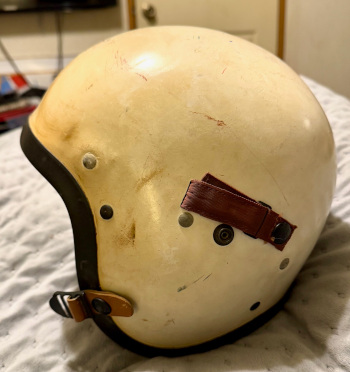
|
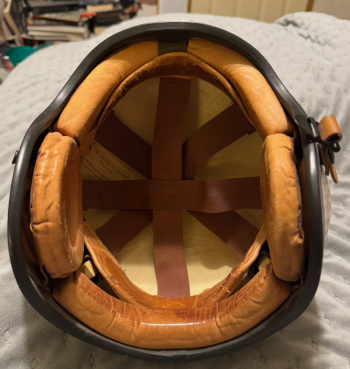
|

|

|
Gentex type 70E-1 model with electronic used for development test as precursor of the H-5 flight helmet (Bellsaviation.com) |
| Another well preserved specimen of Gentex type 70E-1 model used for development test as precursor of the H-5 flight helmet |

|

|

|

|
Another well preserved specimen of Gentex 70E-1 model used for development test as precursor of the H-5 flight helmet. This model has the lateral studs for oxygen mask retention installed on the shell. |
H-5 flight helmet with b-8 goggles and A-13A oxygen mask modified with "Y-yoke" attaching system used on U.S.N. and U.S.M.C. A-13A and MS22001 oxygen mask during the second half of 50s.
|

|

|
H-5 view, note the boom mounted microphone, the leather tabs for oxygen mask fixation and the earphone attached to the internal helmet shell. |
| Gold colored H-5. This "restoration" model has been modified with a external laching cord to better secure the internal earphone typical system used in several USAF helmet series.(Maggot) |

|

|
H-5 helmet with nuclear flash goggles. Note the white and red reflective tape applied in several U.S.N. helmets of that period. |
| US NAVY H-5 in the colour of VA-113 "Stingers". The helmet has been modified with " Christmas tree" bayonet receivers to be used with the late 50s MS22001 oxygen mask. |

|

|

|
H-5 flight helmet retrofitted with USAF style " Spring ears pad" |
| Beautiful specimen of US Navy H-5 flight helmet in its original gold paint. (Bellsaviation.com) |

|

|

|

|
Another H-5 flight helmet retrofitted with USAF avionics. (Bellsaviation.com) |
| Beautiful specimen of US Navy H-5 flight helmet from VF-121 Pacemaker flying on F9F-8 Cougar in 1955 |

|

|

|
Well preserved specimen of US Navy H-5 flight helmet |
|
| Another H-5 flight helmet with original gold color |

|

|
Another interesting specimen of US Navy H-5 flight helmet with origianl gold color (Lars Durehed collection) |
|
 |
Unidentified H type
This helmet, with no specific designation, might to be an early prototype of what became the
H-5, probably developed in parallel with or maybe even prior to the H-4. It might also be a rigger-made mix.
The shell and the communications setup is the same as the H-5 but the oxygen mask tabs with three studs each are like the ones used on the H-2. The strap suspension assembly with adjustable front and rear headband halves is like the one used on the H-3 with two external adjustment buckles on
each side of the helmet. A couple of factors confuse the prototype theory. The grey foam liner looks like the one used in the Gentex MC-1 series of CVC helmets, and the nape strap looks like the one used on the Gentex APH-5A US Army quartermaster flight helmet. |
|
Unidentified H type helmet with external boom mounted microphone. The strap suspension assy are similar to the one used on H-3, the shell and communication setup are similar to the ones of H-5. (DocBoink)
|

|

|
Unidentified H type helmet, as for the H-3, H-4 and H-5 its original color under the grey paint was in gold. (DocBoink) |
| Unidentified H type helmet with B-8 goggles and oxygen mask A-13A. The mask tabs with three studs each are like the ones used on later H-1 and H-2. (DocBoink) |

|
 |
SPH-1
The SPH-1 was developed during the early 50s mainly as helicopter's helmet. Indeed it was also used on limited number on fixed wing aircrafts like the training aircraft SNJ Texan and T-28 Trojan or the attack aircraft Skyraider.
The SPH-1, made by International Latex Corp. was constructed of fiberglass cloth reinforced with epoxy resin. It was equipped with M-6A/UR microphone mounted on chin cup or on external boom. The rows of snaps on each side of the helmet could accomodate an oxygen mask. Goggles could have also been worn foe eye protection. |
|
| SPH-1 flight helmet with boom mounted microphone. This helmet was used by the training squadron VT-3 operating on SNJ Texan and T-28 Trojan during the 50s. (Nick/flightgear.ch) |

|

|
USN SPH-1 with M-6A/UR microphone mounted on chin cup.
(Schiffer Publishing Ltd.) |
| SPH-1 flight helmet with boom mounted microphone and MS22001 oxygen mask. This SPH-1 configuration was also used during the 50s in the Skyraider attack aircraft. |

|

|

|
Interesting specimen of SPH-1 flight helmet with communication plug placed in un-usual posion on the upper lateral side of the shell (Bellsaviation.com) |
| Other beautiful specimen of US Navy SPH-1 flight helmet with B-8 goggles and MS22001 oxygen mask using Y-yoke suspension system. |

|

|

|

|
Beautiful specimen of US Navy SPH-1 flight helmet used by an unidentified unti-submarine squadron |
 |
"FLEX DECK" Project special helmet
During the half of 50s two F9F-7 Cougar received special modifications, mainlly on lower fuselage and wings, for evaluation of a flexible deck landing system. It was thought that by eliminating landing gear, up to a 33% savings in weight could be realized, thus increasing range and performance.
Because the landing impact was more severe than in a regular carrier landing, A special retention harness and helmet was used by the test pilots during flexdeck landings. Approach speed was 135 mph, but with the special harness and helmets, little discomfort was experienced. |
|
The "Flex deck" project special helmet worn by test pilot John Norris. This helmet and the relevant retention harness was developped to prevent injury during the landing impact.
(Grumman) |

|

|
Lateral view of the special helmet with its big chin protection. Note the head retention device integrated part of the special harness. (Grumman) |
 |
"Bill Jack" Model and D-6/D-8/D-10
In the mid 50s the Bill Jack Scientific Instrument Co. developed a flight helmet shell used for different typology of flight helmets. Some of these like the SPH-1 and SPH-2 were intended for use on rotary-wing aircraft. some "Bill Jack" design shell helmets retrofitted with P style visor were also used on jet aircraft. These typology of flight helmets was later manufactured by others company as CalMil, Flight Sound, Protection inc. taking the designation of D-6, D-8 and D-10. These flight helmets incorporate the communication earphone and in the early version an external row of snaps of each side of the shell (later replaced by bayonet retainers) to accomodate the oxygen mask. |
|
| Convair test pilot of XFY-1 POGO with a "Bill Jack" design flight helmet during the 1954. In the first image the helmet is customized with a pivoting visor connected in the upper frontal part of the helmet. Similar style visor was also used on the H-1 helmets (Convair) |

|

|

|
Convair test pilot of XFY-1 POGO John Knebel with a "Bill Jack" design flight helmet during the 1954. This helmet is customized with a detachable visor on which the oxygen inalation system is connected and a pivoting visor connected in the upper frontal part of the helmet (Convair) |
This "Bill Jack" design flight helmet is displayed in the Naval Aviation Museum of Pensacola. Note the oxygen mask quick release bracket placed on the external snaps, the chin cup and the spring shape communication cable.
|

|

|
VF-51 pilots beside a FJ-3 Fury on 1955. They seem to hold "Bill Jack" design flight helmets, recognizable for the external rows of snaps and the clear thick edge roll. In the first from the right also the spring shape communication cable is identifiable.
(US NAVY) |
On this "Bill Jack" design Flight Sound Model D-8 flight helmet the external snaps have been removed and replaced with early typology of oxygen mask straight bayonet receivers.
(John Spencer).
|

|

|
"Bill Jack"design Flight Sound D-8 flight helmet retrofitted with TOPTEX style external visor and Hardman "Christmas tree bayonet" receivers. (Steve) |
On this "Bill Jack" design Model D-8 flight helmet a special visor, manufactured by the company, is installed. Basically to a P-4 style visor an unusual 180° rotating system has been applied (Gato)
|

|

|

|
"Bill Jack" design Flight Sound helmet retrofitted with APH-5 visor hosing and external boom mounted microphone |

|
Another interesting "Bill Jack" design Flight Sound helmet retrofitted with APH-5 visor hosing and external boom mounted microphone. (Bellsaviation.com) |
"Bill Jack" design Model D-8 flight helmet with Hardman "Christmas tree bayonet" receivers P-3 style visor and oxygen mask MS22001 equipped with mini oxygen regulator.
|

|

|

|
"Bill Jack" design helmet with three upper frontal snap studs for visor or sunshade fixation |
| "Bill Jack" design helmet with customized external visor |

|

|

|
"Bill Jack" design helmets retrofitted with TOPTEX style external visor and Hardman "Christmas tree bayonet" receivers |
| "Bill Jack" design helmet with P-3 external visor |

|

|

|
"Bill Jack" helmets labeled as "sound absorb" with special internal padding developed for better sound attenuation. (Bellsaviation.com) |
| US Navy customized "Bill Jack" design helmet made by Protection Inc/MSA with external microphone as used on helicopter during the 50s and early 60s. (snorris) |

|

|

|
Other very unusual customized "Bill Jack" style helmet with not standard external visor, HGU-2A/P earphone assemblies, and APH-6 plug cord |
| Very beautiful specimen of a "Bill Jack" D-6 flight helmet of the middle/late 50s. (Bellsaviation.com)
| 
|

|

|
D-8 "Bill Jack" style helmet customized with P style external visor and straight bayonet receivers.(Bellsaviation.com) |
| Another interesting specimen of a "Bill Jack" D-6 flight helmet of the middle/late 50s.
| 
|

|

|

|
Beautiful D-8 "Bill Jack" style helmet customized with P style external visor and christmas tree bayonet receivers.(Al Casby) |
| Back view of the same helmet which was used by F7U Cutlass pilot during the second half of the 50s. (Al Casby)
| 
|

|

|
D-8 "Bill Jack" customized with P-4A style external visor and christmas tree bayonet receivers, in the color of VA-86 during the early of the 60s. |
| US Navy D8-50 "Bill Jack" from VA-95 used on AD-7 Skyraider during the second half of the 50s.
| 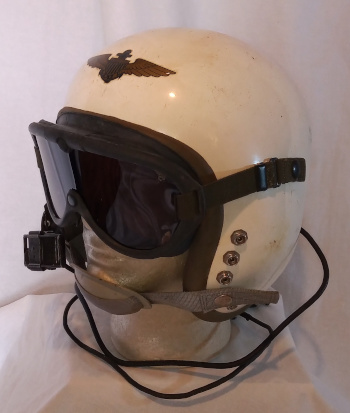
|
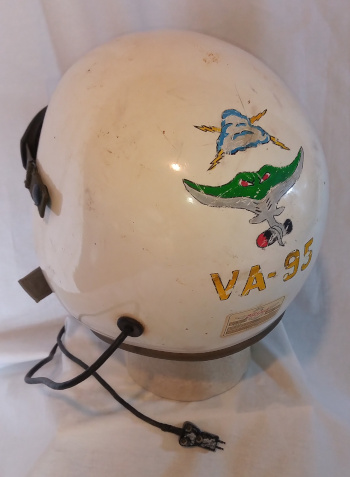
|
 |
P and MB serie helmets in naval service
The P serie (P-1 to P-4) was the first standard issue hard flight helmets serie for the US Air Force utilized from the late 40's till the early 60's.
Even if these helmets were mainly used by the USAF pilots and flight crew, evidences show that in several cases the US Navy or US Marines pilots also worn the P serie helmets. |
|
LCDR Don "Flash" Gordon in a FJ-1 Fury on 1949 wearing a P-1 helmet and A-14 oxygen mask. The helmet was modified with an external boom mounted microphone normally present on US NAVY flight helmet of the 50s. (US NAVY)
|

|

|
VF-51 Korean war veterans beside a F9F-2B Panther on 1951. In the second row the second pilot from the left seems holding a P-3 helmet. All the others pilots have H-3 helmets. (US NAVY) |
| CDR James D. "Jig Dog" Ramage beside his F2H-3 Banshee on 1953 wearing a P-3 helmets. CDR Ramage was the CAG of Air Group 19 on board of USS Oriskany. (Schiffer Publishing Ltd.) |

|

|
US Navy pilot flying a F7U-3 Cutlass on 1955. He seems wearing a "P" serie helmet and MS22001 oxygen mask. (US NAVY) |
| VF(AW)-3 pilots beside a F4D-1 Skyray on 1959. four of the helmets are more likely P-4A or P-4B type, decorated with squadron color and marking. The other ones are APH-5. (US NAVY) |

|

|
USMC pilot on F4D Skyray in 1958 is wearing a P-4 flight helmet with external visor removed. (US NAVY) |
| P-1B helmet that has been upgraded to a P-4 style Helmet. This helmet was procured by the MARINES Corps. It is identified to the MARINES fighter pilot David Opelt. (Bellsaviation.com) |

|

|

|
USN P-4A with "Christmas tree bayonet" receivers and H-87A/U or H87B/U headset. |
| This P-4A Helmet was more likely used by USAF pilot on Naval aircraft as attested by the US NAVY standard comms U-75/U plug on the comm cord and the M-6/UR boom microphone. |

|

|
USN P-1A of the early 50s. This helmet was used by Ltjg Eugene Scott |
| P-4B Helmet coverted in P-4A on "479CAMS PROJECT". This helmet seems to be used during the late 50s by USN pilot Lefty Schwartz more likely on the F11F-1F Supertiger. |

|

|
USN pilot of VX-5 inside a FJ-4B Fury wearing a P-3 flight helmet. China Lake, circa 1957. (US Navy) |
| US Navy pilot from from VF-5A (VF-51) during the 1948 is wearing a P-1 helmet on FJ1 Fury (US Navy) |

|

|
USN P-1B dated 1954 with external boom mounted microphone. The decal in the upper part of the helmet is related to the US Navy Reserve NAS Minneapolis |
| P-4A configured for Navy use with MS 22001 oxygen mask plus oxygen regulator and REDAR hose. This helmet was used on F-11F Tiger and probably on F-8 Crusader of Naval Reserve. |

|

|

|
P-1B used for the STRATO-LAB project.
Project Strato-Lab was a high-altitude manned balloon program sponsored by the United States Navy during the 1950s and early 1960s. The Strato-Lab program lifted the first Americans into the upper reaches of the stratosphere since World War II. Project Strato-Lab developed out of the Navy's unmanned balloon program, Project Skyhook. |
| US Navy test pilot in FJ4 Fury cockpit with P Type helmet modified with two movie cameras to film the F4D-1 Skyray's performance during flight test at China Lake on June 1958. |

|

|
US Navy Cougar pilots of VF-142 with P type helmets during the 1955. (US Navy) |
| Very interesting US Marines P-1A retrofitted with P-3 style visor from VMF-115 used in 1954 with MS 22001 oxygen mask. |

|

|

|

|

|
Very unusual US Marines customized helmet on which the internal arrangements seem to be a P-3, The earphone cushions appear to be vintage P-1/P-3 type with an APH-5 or APH-6 type visor assembly, both the leather tabs and external bayonet receiver for oxygen mask are present. It is equipped with a WW2 type A-14 oxygen mask. |
| US Marines pilot John Glenn wearing a P-1A or P-3 helmet while flying on his Panther during the Korean War (US Navy) |

|

|
US Navy pilot CDR Dusty Rhodes wearing a P-1A or P-3 helmet while flying on his Cougar of VF-121 in October 1954 (US Navy) |
| Nice specimen of 1953 US Navy P-1B retrofitted in P-3 with external mounted boom microphone. |

|

|

|
US Navy pilot CDR Laurence W. Abbott Commanding Officerof VF 153 on board of USS Wasp in 1956 wearing a P-4 flight helmet.
Note that despite CDR Abbott was a Navy pilot he left the original USAF decal on the P-4 helmet. (US Navy) |
| US Marines pilot MAJ V.E. Allen Commanding Officer of VMA 223 on board of USS Wasp in 1956 wearing a P-3 flight helmet. (US Navy) |

|

|

|
Rare and well preserved P-1 flight helmet in US Navy configuration with external boom mounted microphone and A-14 oxygen mask. (Bellsaviation.com) |
Very interesting preserved P-3 flight helmet with US Navy squadron color marking.
The same pilot was also used an H-3 (colored with the same squadron design) as show in the above dedicated section. (Bellsaviation.com) |

|

|

|

|
Nice specimen of 1959 US Navy P-4B of VF(AW)-3 Blue Nemesis used on Skyray. |
| Very rare P-1 flight helmet used by a Blue Angels pilot during the early of the 50s. |

|

|

|
Very interesting specimen of 1957 US Navy MB-4 of VA-44 Hornets used on Cougar. |
DH-5-3 or H-6
The DH-5-3 was developed by Gentex in the mid 50s to replace the H-4 and H-5. Its shell was constructed of a fiberglass cloth reinforced with epoxy resin and internal suspension system adjustable by external straps was used. The DH-5-3 incorporates the earphone so no internal cloth helmet was used, the oxygen mask was secured to fast snap bottoms on external leather tabs. The external visor was moved and secured by means of two lateral tracks system. The US Navy chose the APH-5 so this helmet never reached the operational service and approximately 100 DH-5-3 were made.
It seems that this helmet was also designated as H-6 |
|
Gentex DH-5-3 with interim type of external visor. The visor was secured by two unique design lateral tracks. (Gentex)
|

|

|
The internal suspension system was adjustable by two external straps. (Gentex) |
| Interesting Gentex DH-5-3 (H-6) USN Navy flight helmet with early type of external visor. The identification label inside this specimen shows the designation as Gentex H-6 . |

|

|

|
The internal suspension system of the DH-5-3 (H-6) is basically the same of the H-5. |
| Well preserved Gentex DH-5-3 (H-6) US Navy flight helmet. approximately 100 DH-5-3 (H-6) were made. |

|

|

|
Rear view of DH-5-3 (H-6) also the communication cord arrangement is the same used on the H-5. |
| DH-5-3 (H-6) flight helmet tested by Gentex in the middle of the 50s. (Bell's Aviation Museum) |

|

|

|
Gentex DH-5-3 flight helmet. This helmet has the same internal suspension system and the avionic of the H-5 model. |
| Well preserved Gentex DH-5-3 with later type of dark visor and A-13A Oxygen mask. |

|

|
 |
BBC-X2
An article in the January 1957 issue of Approach described the development leading to the APH-5 helmet. Among other things it stated that that the most promising helmet under development, the BBC-X2, would incorporate a new helmet shape plus a novel means of providing individually moulded fits. Using an epoxy resin for the energy absorption material, non-technical personnel at the squadron level would be able to make individual head moulds which would be placed in the new shell, covered with a thin, comfort layer of sponge rubber with an inner lining of chamois. The visor would retract between the outer shell and the energy absorption layer. The article further mentioned that the BBC-X2 was a joint development between the US Navy and the US Air Force, and that the helmet was intended eventually as a replacement for the APH-5.
|
|
| Although it is unmarked this helmet of the early 50s it is highly likely the BBC-X2 . This helmet represent one of the designs studied in the process that lead to the APH-5 helmet.(Bloodhound and Best of Flightgear) |

|

|

|
Frontal and lateral images of the possible BBC-X2. The helmet was equiped with external boom mounted microphone. (Bloodhound and Best of Flightgear) |
| The BBC-X2 shows a visor that retracts inside the shell, this visor design is similar to the one later used in same French Gueneau flight helmets. The internal shell was covered with a thin, comfort layer of sponge rubber with an inner lining of chamois and incorporated earpads. (Bloodhound and Best of Flightgear) |

|

|

|
The BBC-X2 shows an unique back arrangement of the webs adjustment and comunication cord insertion.(Bloodhound and Best of Flightgear) |
 |
MSA-N2 or APH-5
The MSA-N2 later designated as APH-5 was the first US Navy helmet incorporating the visor housing. Its shell was constructed of a fiberglass cloth reinforced with epoxy resin. The APH-5 incorporate the earphone and sometimes also an external boom mounted micriphone was present. This helmet was used with MS22001 oxygen mask which was attached to snaps on leather tabs on earlier MSA-N2 and APH-5s, Hardman "Christmas tree bayonet" or straight bayonet receiver have been installed in the later version.
The neutarl grey or trasparent visor was moved and locked in the MSA-N2 and APH-5 earlier version by means of a round knob incorporating a push buttom locking device, classical "star" locking knob was present in the APH-5 later version. |
|

|
A pilot at Naval Air Materiel Centre wearing an
MSA-N2 prototype helmet. This type of flight helmet was later designated as APH-5. The picture was taken as early as 26 October 1954, documenting the long development process that lead to the service introduction of the MSA-N2 and APH-5 helmet 18 months later. (US Navy and Bluelight) |

|

|

|
Probably early prototype of APH-5 or MSA-N2 helmet, with very likely the first style communication cord set up and plug. This helmet was later retrofitted with Christmas tree bayonet receivers (Steve Vallejo) |
Early version of APH-5 dated 1957 with MS22001 oxygen mask. Note the "Y-yoke" suspension system of the oxygen mask attached to the helmet's snaps on leather tabs.
|

|

|
Squadron colored APH-5 with Hardman "Christmas tree bayonet" receivers and MS22001 oxygem mask. This model was utilized from VF-211 pilot flying the F11F-1 Tiger on 1959. |
| Gold colored and reflective tape added APH-5 dated 1960. This model was equipped with external boom mounted microphone and MS22001 oxygen mask which mount a mini oxygen regulator attached directly under the mask body as used in some US Navy MS22001 models during the late 50s early 60s. |

|

|
USMC VMFA-513 APH-5 helmet with early type of straight bayonet receivers and MS22001 oxygen mask with a mini oxygen regulator. (Milehight) |
In 1958 some APH-5 have been modified with a pair of gun cameras. The helmet chase camera was used to record tank and stores separation from FJ-3 and FJ-4 Fury jet fighters as well as aircarft action in spin test, high speed pullups and drive brake effects.
(US NAVY) |

|

|
Unusual customized variant of APH-5 retrofitted with APH-6B one piece visor housing and lateral large plastic round washers. |
| Even if at first sight this helmet seems to be an APH-6A it is instead an early APH-5 with leather tabs retrofitted with APH-6A visor housing and modified for better noise attenuation. This helmet was used by VS-41 flying on S2F Tracker during the 60s. |

|

|
APH-5, with traight bayonet receivers, used by CAG of Carrier Air Wing 15 during the early 60s. |
Late 60's customized variant of APH-5 retrofitted with APH-6B one piece visor housing and avionics. External boom mounted microphone is also installed . |

|

|
APH-5 painted with the bumblebee design of VA-113 "Stingers" retrofitted with APH-6A plastic round washers and later avionics. Note the central snap bottom probably used to fix the nuclear flash protective goggles. This helmet, now displayed at Naval Aviation Museum of Pensacola, belonged to former Astronaut Cap. Eugene A. Cernan when he was flying on Skyhawk of VA-113 on 1963. |
Late 50's APH-5 with Hardman "Christmas tree bayonet" receivers and a rare MARINES decal on visor housing . |

|

|
Another APH-5 modified for possible use on S-2 Tracker in accordance with NAS Norfolk Virginia instructions. Similar modification for better noise attenuation were also performed on APH-6 helmets utilized on S-2 Tracker. This helmet seems to be used with US Navy A-14A oxygen mask. |
US Navy Late 50's APH-5 and MS 22001 oxygen mask with early hard shell retention system. This helmet was used by a pilot of an S2 Tracker anti sub aircraft. |

|

|
A very beautiful APH-5 early variant and oxygen mask MS 22001 with mini pressure regulator and REDAR hose as used during the middle/late of the 50s.
This helmet is painted in the colour of the VF-32 "Swordmen" and it was used on F8U-1 Crusader during the 1957-1958. |
| APH-5 late variant modified with double visor kit as used during the middle/late of the 60s. (Jpayne) |

|

|

|
An interesting specimen of APH-5 retrofitted with P-4 style avionics (Steve Vallejo) |
| APH-5 late variant of the early 60s in marking of the US Navy squadron VF-162 "Hunters" |

|

|
APH-5 with an unusual light blue liner. This was an US Navy modification in accordance with NAS NORVA (Naval Air Station Norfolk Virginia) introduced on APH-5 and APH-6 helmets to get better noise attenuation for sonar system operators in S-2 Tracker aircraft. (c7zx) |
| USMC APH-5 with christmas three bayonet receivers and MS 22001 oxygen mask |

|

|

|

|
US Navy APH-5 from VS-25 modified for utilization on S2F Tracker. This helmet was used by Lt. H.L. Adams |
| US Navy APH-5 from VFAW-3 used on F4D-1 Skyray during the 1959 by Captain H.P. Ady |

|

|

|

|
US Navy APH-5 modified for utilization on Marine patrol and ASW aircraft P2V Neptune. |
| US Navy APH-5 early variant in the color of the Blue Angels Aerobatic Team used on F-11 Tiger during the middle of the 50s |

|

|

|
US Navy APH-5 late version of the early-middle 60s with MS22001 oxygen mask with pressure regulator and REDAR hose as used on F-4 Phantom or A-5 Vigilante. (Bellsaviation.com) |
| CDR J.P. Skyrud Executive Officer of VF-21 on board of USS Ranger in 1967 flying on F-4 Phantom is wearing a strange customized configuration of APH-5 late variant flight helmet with the external visor cover removed. |

|

|

|
APH-5 late variant flight helmet configuration custom modified with the external visor cover removed. |
| Other image of the same APH-5 late variant flight helmet configuration custom modified with the external visor cover removed. |

|

|

|
US Navy APH-5 late version of the early 60s from VF-84. This helmet belong to Capt. Gerald Johnson CO of the VF-84 in 1961 flying on F8U-2 (F-8C) Crusader. (Blaster) |
| Another awesome US Navy APH-5 late version of the early 60s from VF-84. This helmet was used by a pilot of the VF-84 in 1963 flying on F8U-2 (F-8C). |

|

|

|
US Navy APH-5 late version of the middle of the 60s with MS 22001 Oxygen Mask and REDAR hose from VF-154. This helmet was used on F-4B Phantom II. |
| Another awesome US Navy APH-5 late configuration retrofitted with rams horn double visor housing and APH-6 style plastic earcup retainer. |

|

|

|
US Navy MSA-N2 or very early APH-5 flight helmet used in 1957 by Maj John H. Glenn during his "Project Bullet" speed record on F-8U-1P Crusader. |
| Colorful US Navy APH-5 middle configuration, probably belonging to a Test Pilot of the Chance Vought Aircraft Inc. |

|

|

|

|
US Navy MSA-N2 or very early APH-5 flight helmet retrofitted with Christmas tree bayonet receivers from the Squadron VF-173 Jesters . |
| US Navy APH-5 late configuration, From VF-33. This helmet belong to Lt. Bill Casey F-8 Crusader pilot during the 1963.(Bill Casey) |

|

|

|
US Navy late APH-5 flight helmet in the color of VF-111 Sundowners in 1963 used on F8-D Crusader. |
| US Navy APH-5 christmas three bayonet receiver configuration, retrofitted with APH-6A earpads with external plasstic disk |

|

|

|

|
US Navy late APH-5 flight helmet in the color of VA-64 Black Lancers in 1963 used on A-4 Skyhawk (Brian Montague). |
| Very interesting US Navy APH-5 late variant retrofitted with OMNITECH double visor (Chris Hoglan collection) |

|

|

|

|
US Navy APH-5 flight helmet in the color of Naval Air Test Center used during the late of the 50s early 60s. |
| Beautiful US Navy APH-5 interim variant in the color of VF-84 "Vagabonds" during the late of the 50s when the squadron was flying the FJ-3 Fury. After this period the VF-84 takes the name of "Jolly Rogers" after the VF-61 was destablished. (Luke Knollinger collection) |

|

|
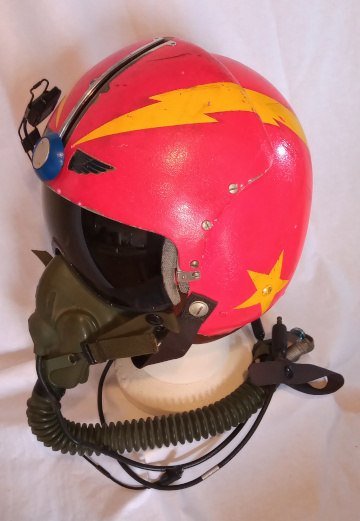
|
US Navy APH-5 flight helmet in the color of VF-74 "Be Devilers" during the second half of the 50s. |
| Based on the nomenclature of this specimen the last variant of the APH-5 was the APH-5A which shows some elements in common with the APH-6A |
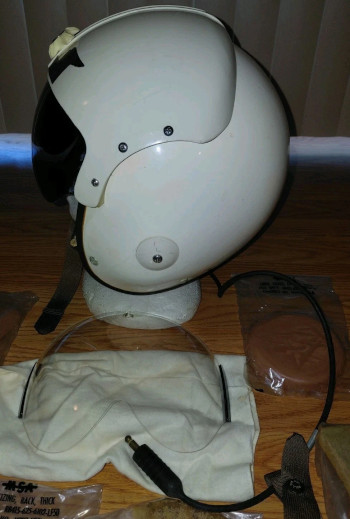
|
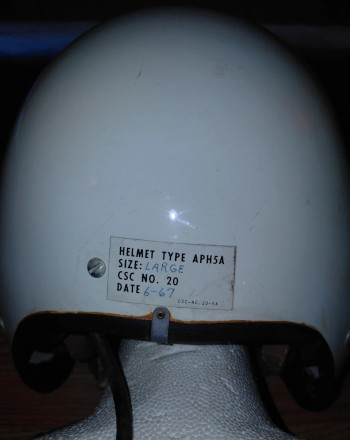
|
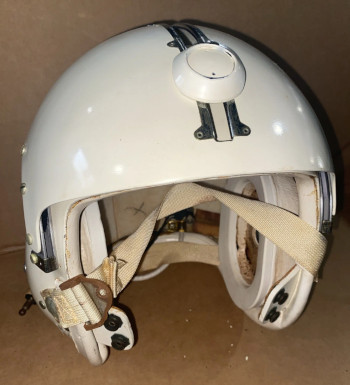
|
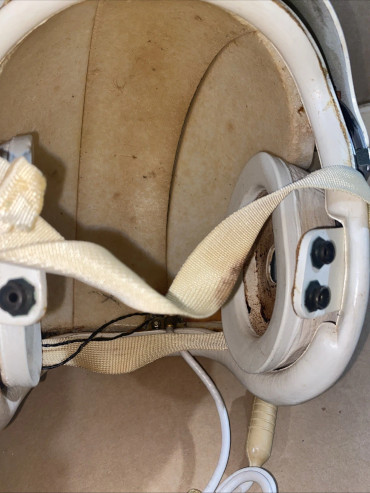
|
Rare variant of US Navy APH-5 in white configuration probably issued for nuclear mission evaluation test during the late of the 50s |
 |
DH-51-4 or DH-51-1 and DH 53-1
The Gentex DH-51-4 or DH-51-1 and DH-53-1 were developed in the late 50s to be used by U.S.N. in reconnaissance and patrol aircraft, as well as in helicopters. The shell was constructed of a fibergalss cloth reinforced with epoxy resin, it was compoude by receivers, external neutarl grey visor and boom mounted microphone.
The later variants of this helmet were modified with different receivers and visor protective housing. These variants used during the 60s were later denominated BPH-1. |
|

|
Gentex early variant of DH-51-4 developed for reconnaissance and patrol aircraft. (Gentex) |
Gentex late 50s early variant of DH-51-4 (Gentex)
|

|

|
U.S.N. early 60s variant of DH-51-4 with modified receivers. The external visor and relevant tracks have been removed. |
| U.S.N. early 60s variant of DH-51-4 with modified receivers and visor protective housing. |

|

|
Internal suspension system and communication earpads of the U.S.N. early 60s variant of DH-51-4. |

|

|
US Navy late 50s and early 60s helmet marked as DH-51-1 |
| US Navy late 50s helmet marked as DH-53-1 without external visor and with a very interesting color pattern. |

|

|

|

|
Same DH-53-1 flight helmet with external visor. This kind of visor was also sometime used on some early 50s jet fighter US Navy Flight Helmet. |
|















































































































































































































































































































































